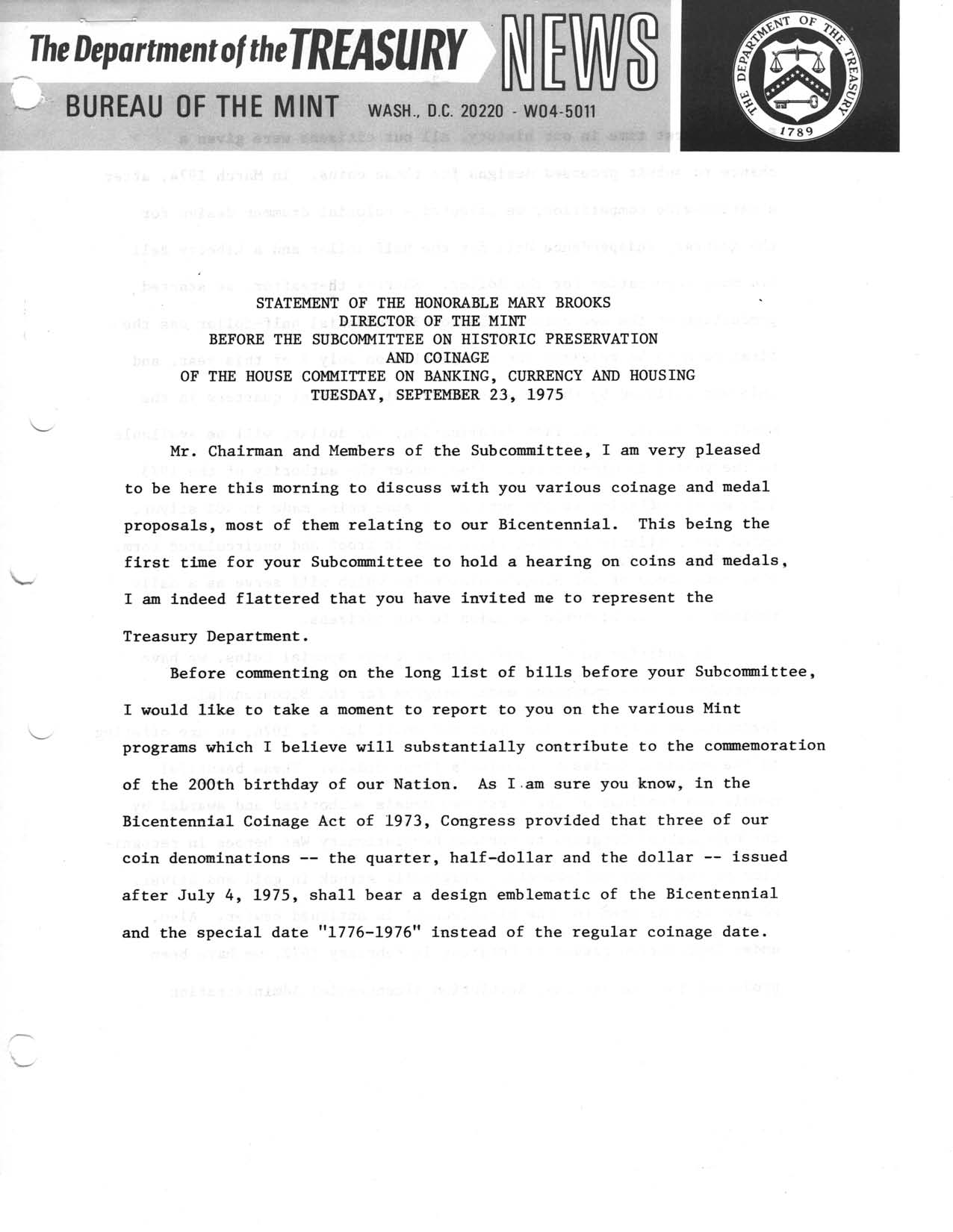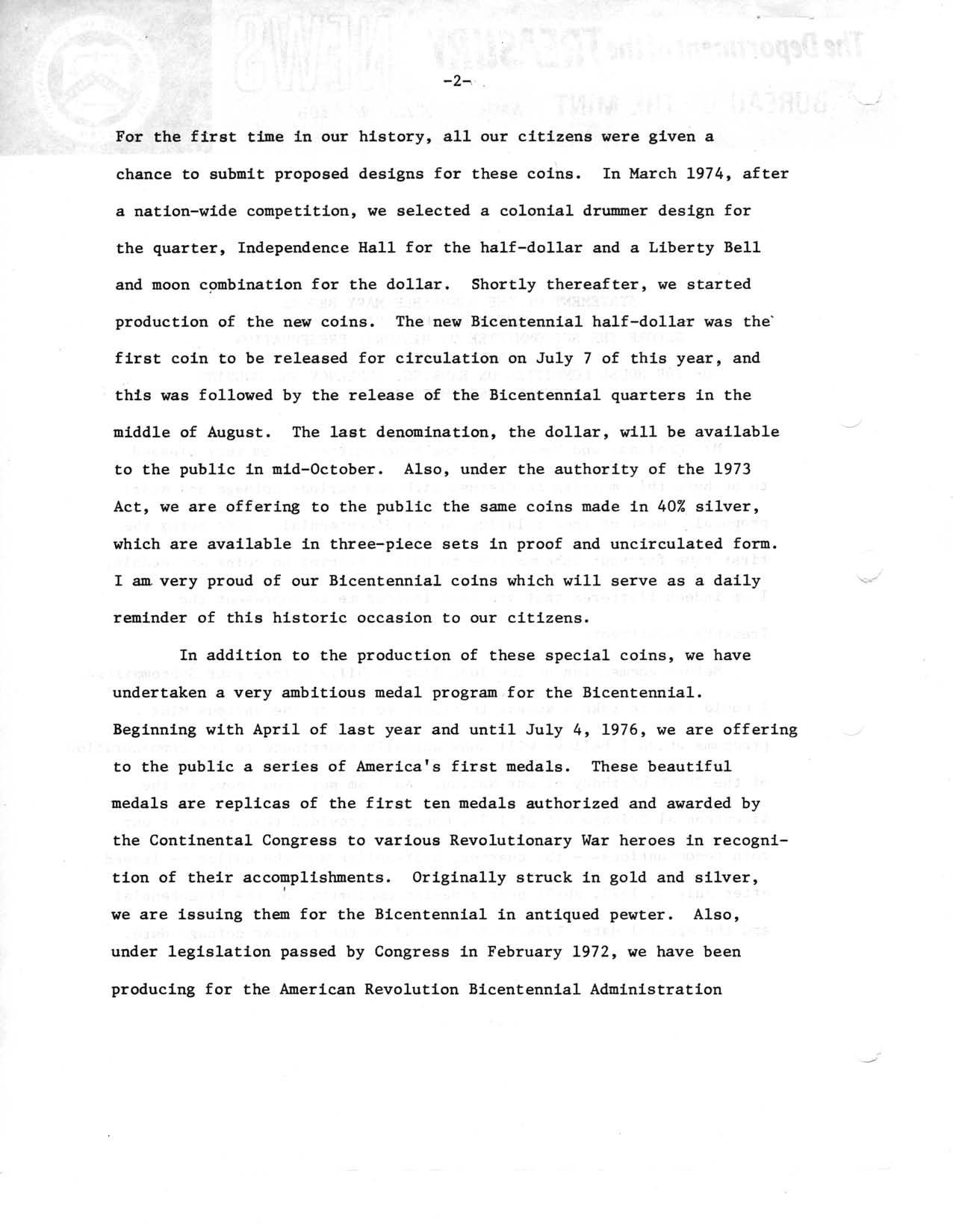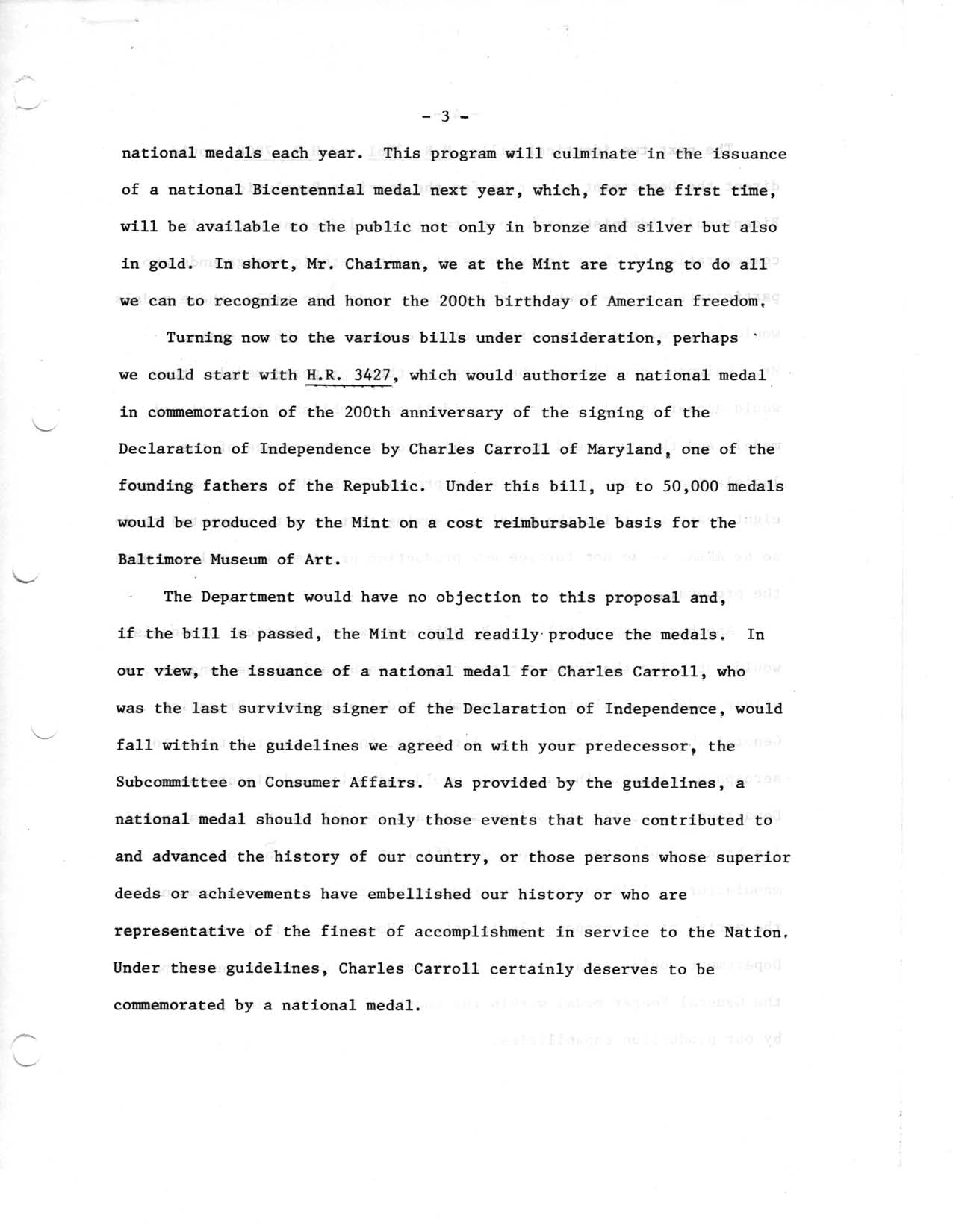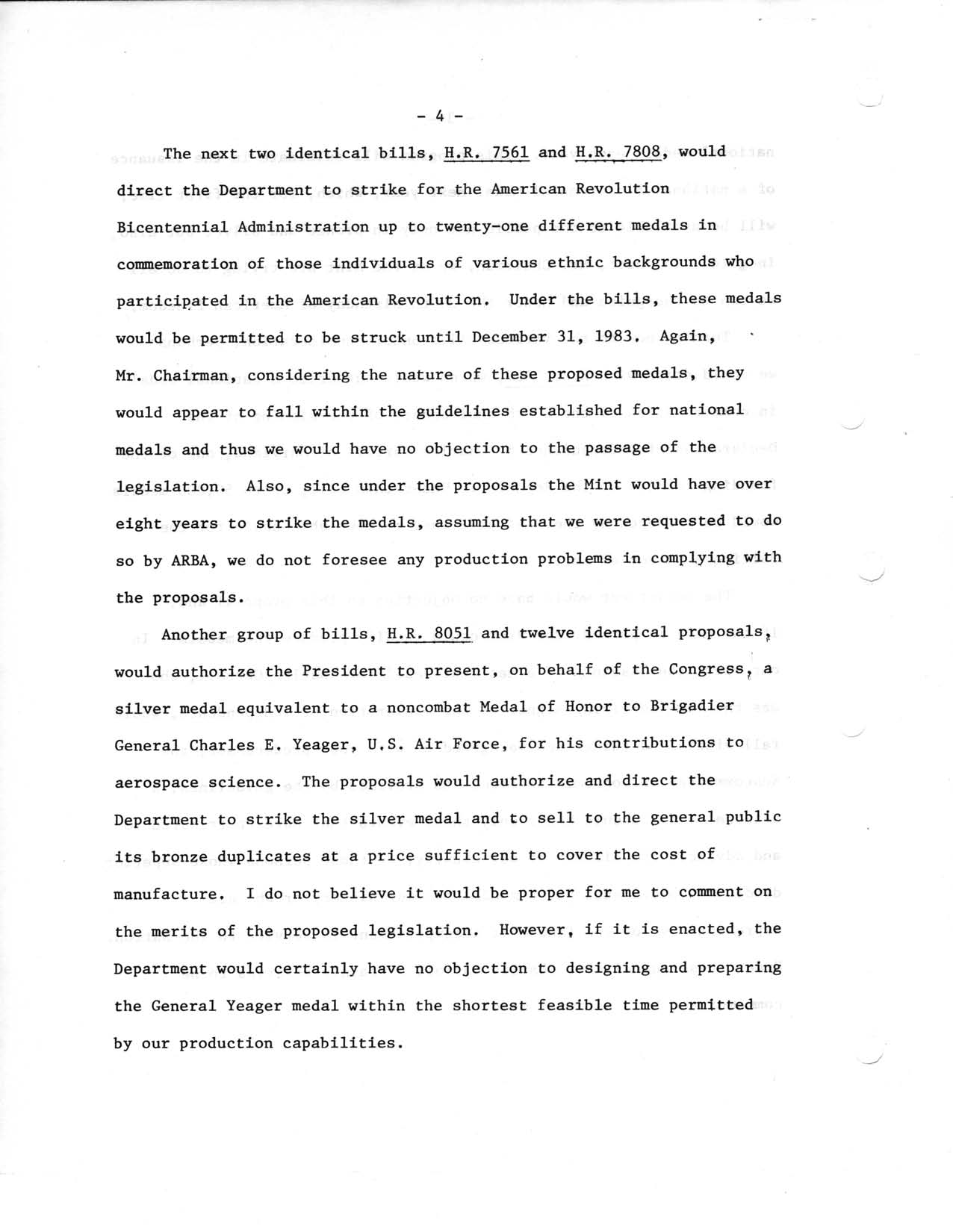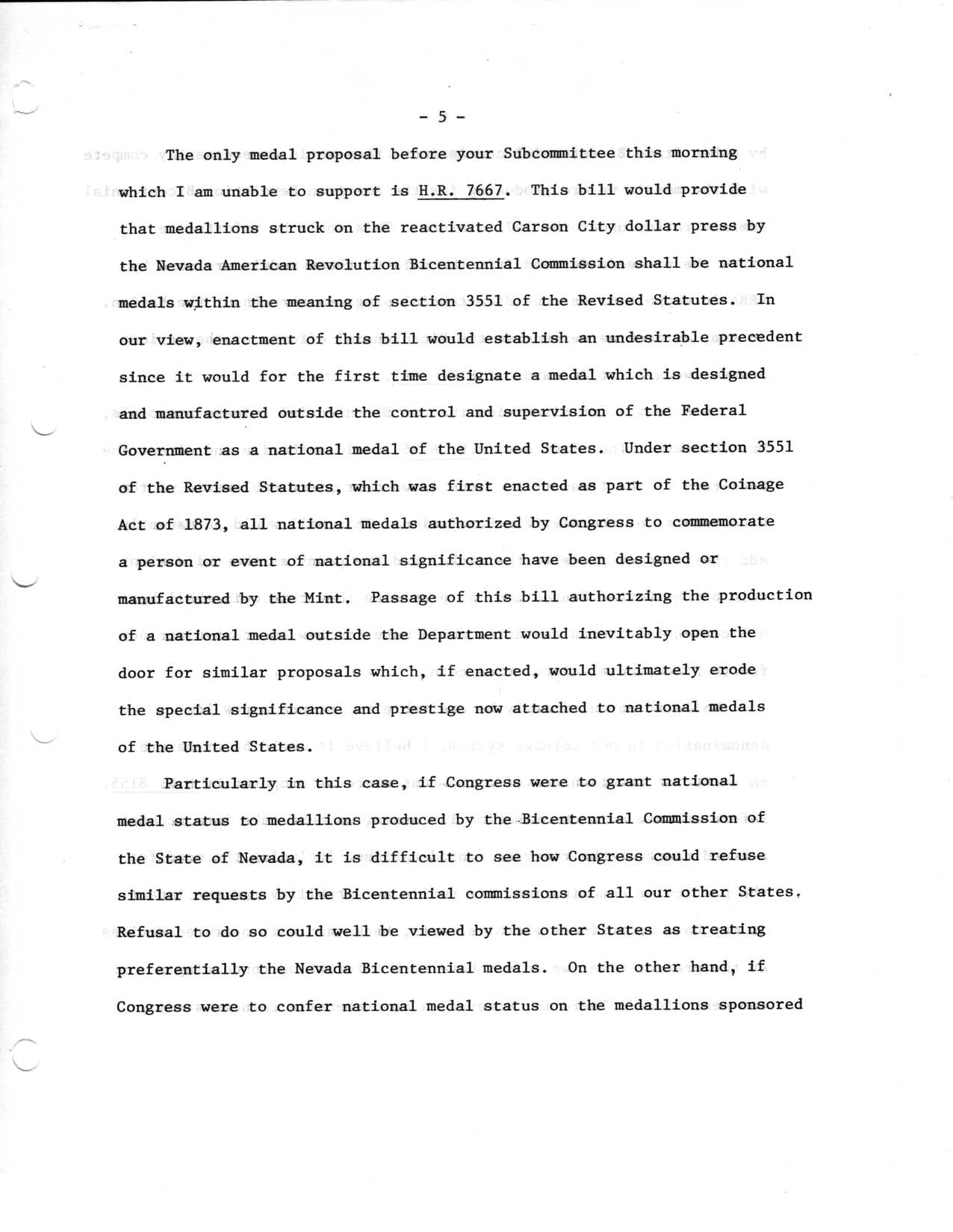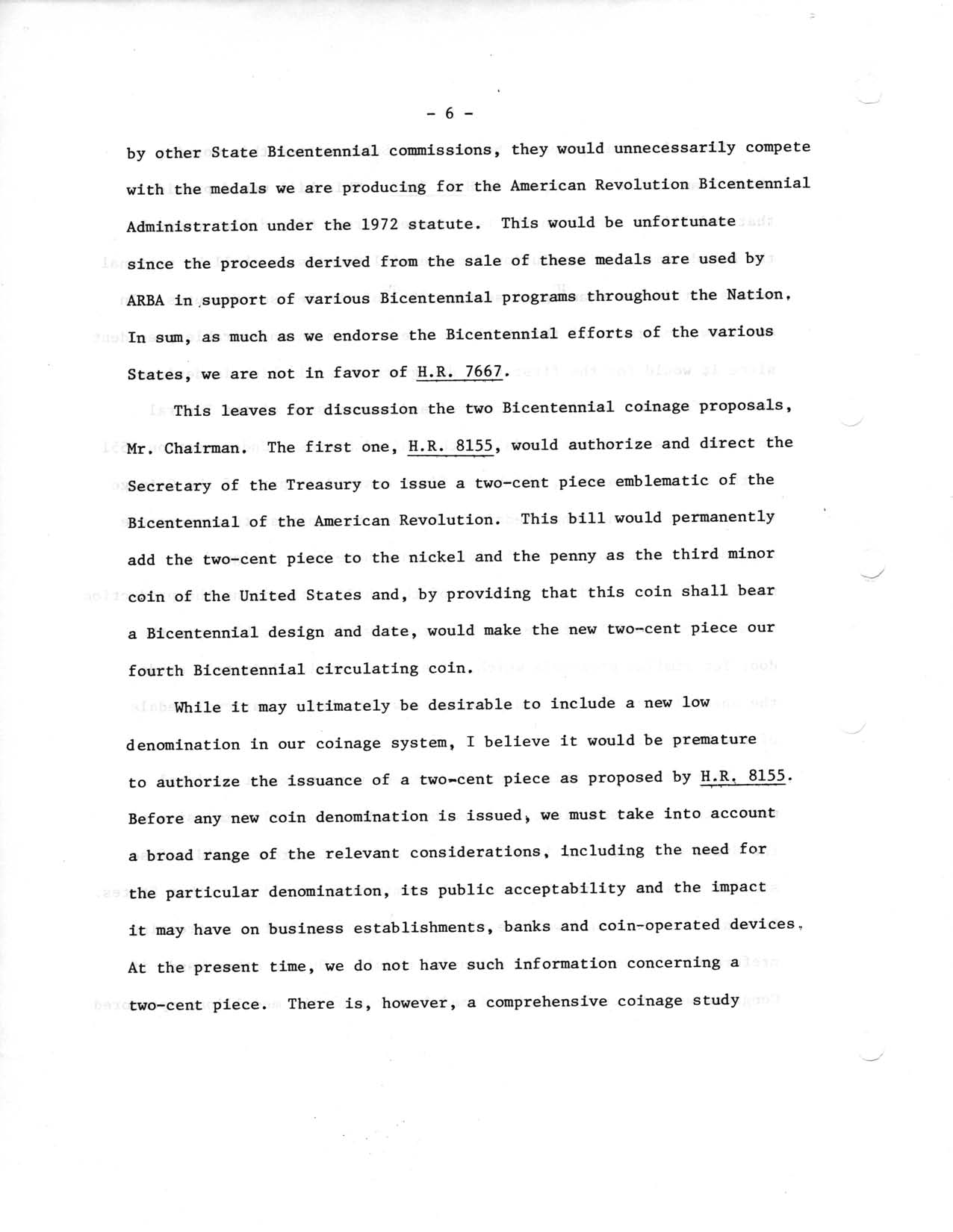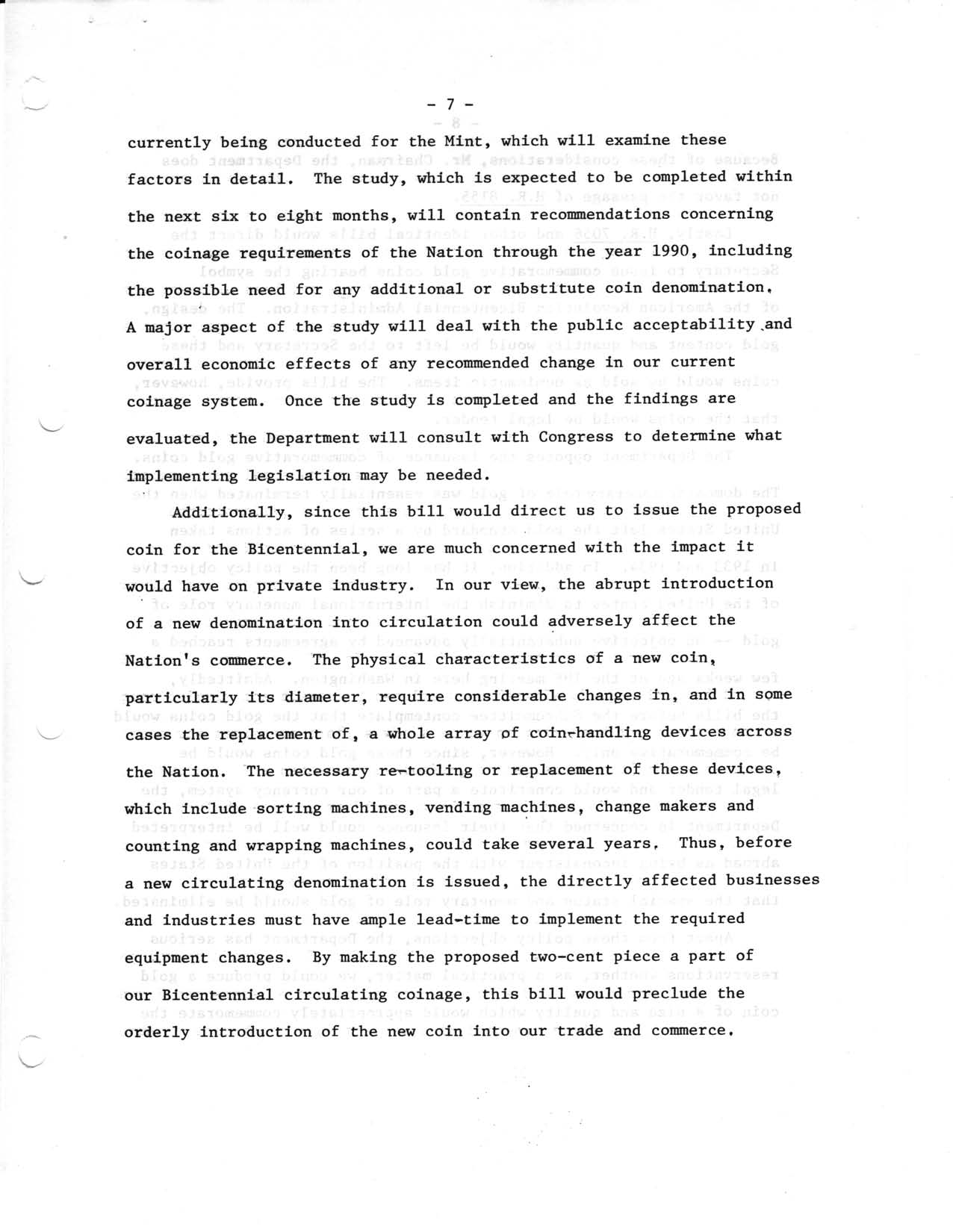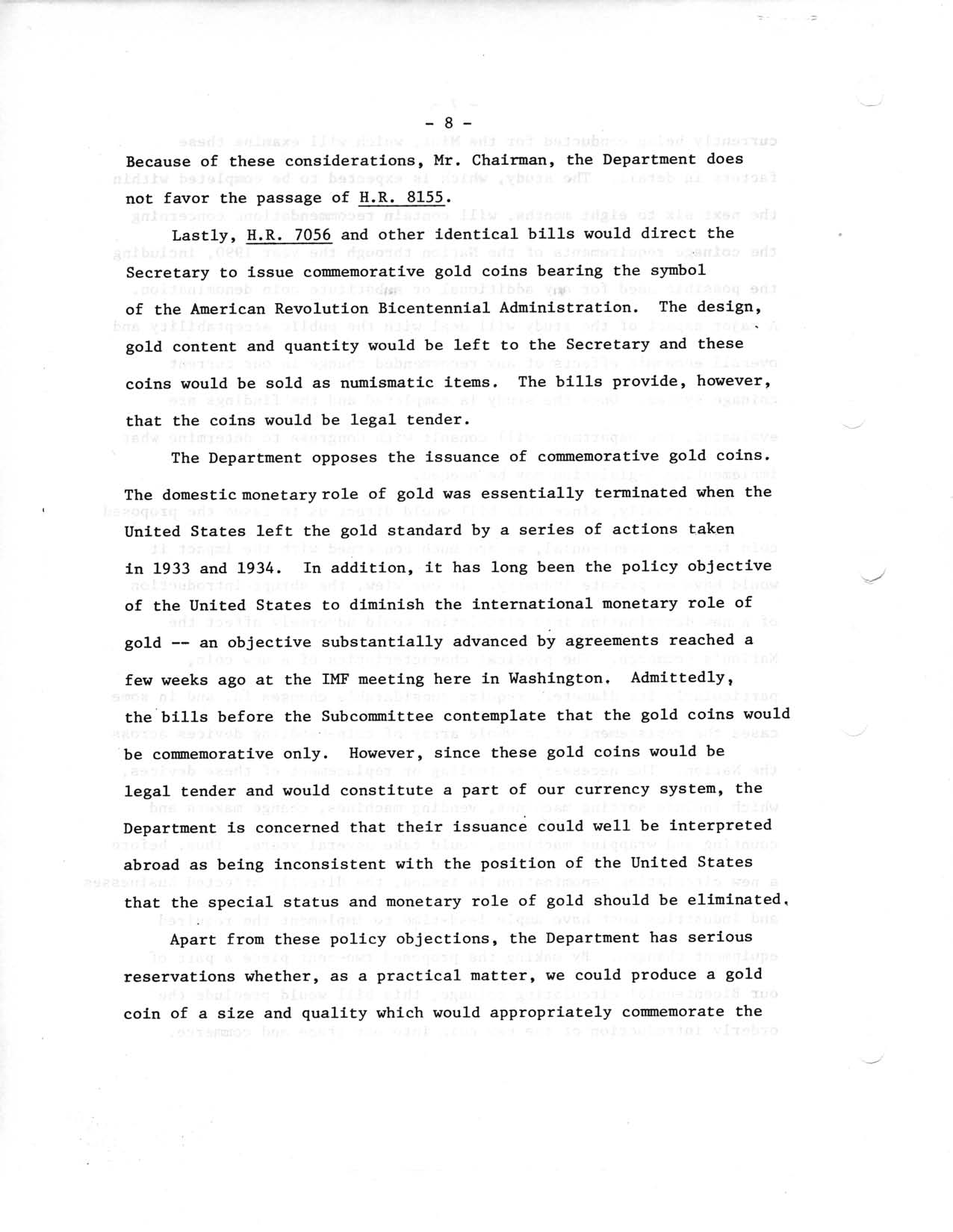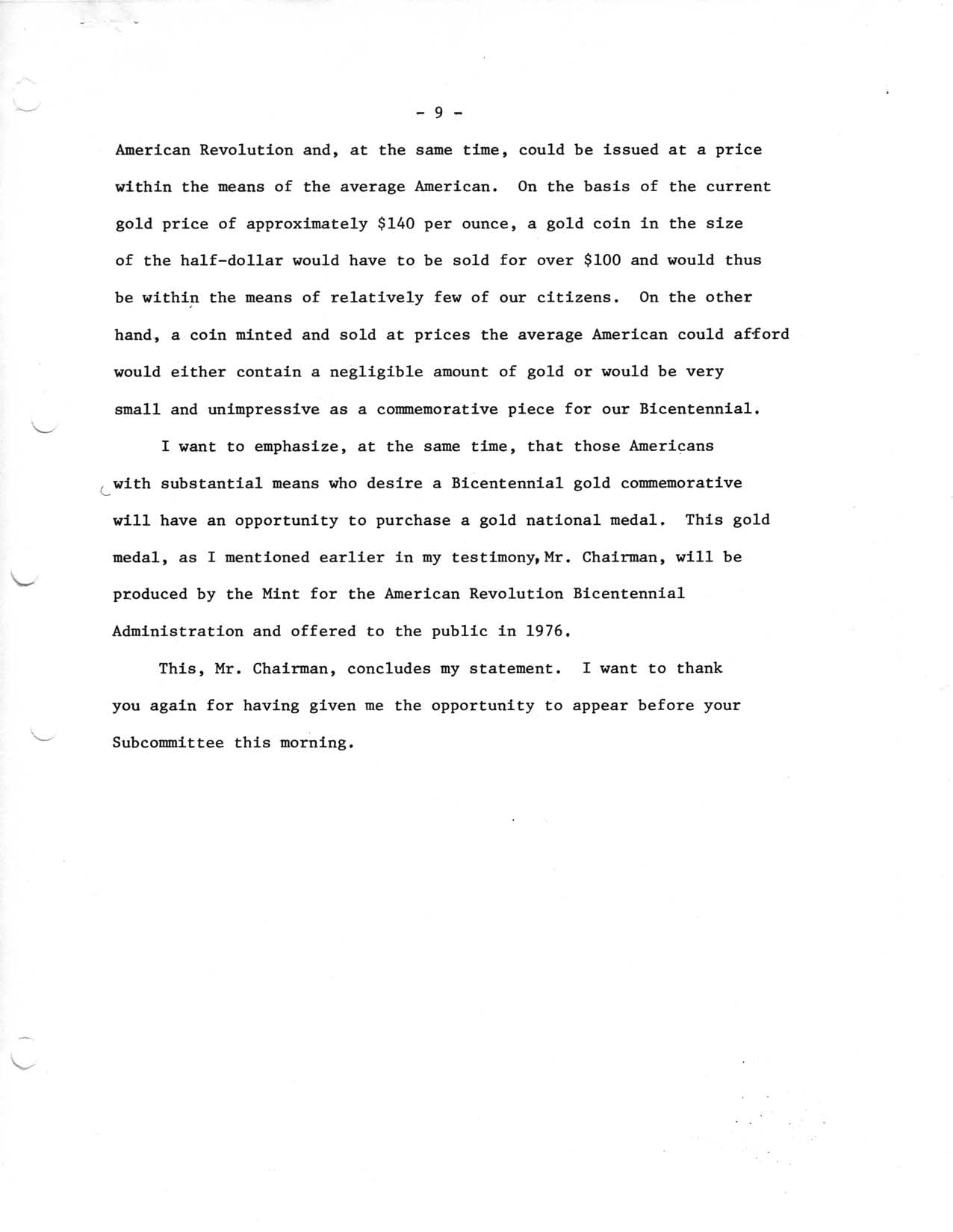Statement of the Honorable Mary Brooks Director of the Mint Before the Subcommittee on Historic Preservation and Coinage of the House Committee on Banking, Currency and Housing Tuesday, September 23, 1975
Press Release
September 23, 1975
Mr. Chairman and Members of the Subcommittee, I am very pleased to be here this morning to discuss with you various coinage and medal proposals, most of them relating to our Bicentennial. This being the first time for your Subcommittee to hold a hearing on coins and medals, I am indeed flattered that you have invited me to represent the Treasury Department.
Before commenting on the long list of bills before your Subcommittee, I would like to take a moment to report to you on the various Mint programs which I believe will substantially contribute to the commemoration of the 200th birthday of our Nation. As I am sure you know, in the Bicentennial Coinage Act of 1973, Congress provided that three of our coin denominations—the quarter, half-dollar and the dollar—issued after July 4, 1975, shall bear a design emblematic of the Bicentennial and the special date “1776-1976” instead of the regular coinage date.
For the first time in our history, all our citizens were given a chance to submit proposed designs for these coins. In March 1974, after a nation-wide competition, we selected a colonial drummer design for the quarter, Independence Hall for the half-dollar and a Liberty Bell and moon combination for the dollar. Shortly thereafter, we started production of the new coins. The new Bicentennial half-dollar was the first coin to be released for circulation on July 7 of this year, and this was followed by the release of the Bicentennial quarters in the middle of August. The last denomination, the dollar, will be available to the public in mid-October. Also, under the authority of the 1973 Act, we are offering to the public the same coins made in 40% silver, which are available in three-piece sets in proof and uncirculated form. I am very proud of our Bicentennial coins which will serve as a daily reminder of this historic occasion to our citizens.
In addition to the production of these special coins, we have undertaken a very ambitious medal program for the Bicentennial. Beginning with April of last year and until July 4, 1976, we are offering to the public a series of America’s first medals. These beautiful medals are replicas of the first ten medals authorized and awarded by the Continental Congress to various Revolutionary War heroes in recognition of their accomplishments. Originally struck in gold and silver, we are issuing them for the Bicentennial in antiqued pewter. Also, under legislation passed by Congress in February 1972, we have been producing for the American Revolution Bicentennial Administration national medals each year. This program will culminate in the issuance of a national Bicentennial medal next year, which, for the first time, will be available to the public not only in bronze and silver but also in gold. In short, Mr. Chairman, we at the Mint are trying to do all we can to recognize and honor the 200th birthday of American freedom.
Turning now to the various bills under consideration, perhaps we could start with H.R. 3427, which would authorize a national medal in commemoration of the 200th anniversary of the signing of the Declaration of Independence by Charles Carroll of Maryland, one of the founding fathers of the Republic. Under this bill, up to 50,000 medals would be produced by the Mint on a cost reimbursable basis for the Baltimore Museum of Art.
The Department would have no objection to this proposal and, if the bill is passed, the Mint could readily produce the medals. In our view, the issuance of a national medal for Charles Carroll, who was the last surviving signer of the Declaration of Independence, would fall within the guidelines we agreed on with your predecessor, the Subcommittee on Consumer Affairs. As provided by the guidelines, a national medal should honor only those events that have contributed to and advanced the history of our country, or those persons whose superior deeds or achievements have embellished our history or who are representative of the finest of accomplishment in service to the Nation. Under these guidelines, Charles Carroll certainly deserves to be commemorated by a national medal.
The next two identical bills, H.R. 7561 and H.R. 7808, would direct the Department to strike for the American Revolution Bicentennial Administration up to twenty-one different medals in commemoration of those individuals of various ethnic backgrounds who participated in the American Revolution. Under the bills, these medals would be permitted to be struck until December 31, 1983. Again, Mr. Chairman, considering the nature of these proposed medals, they would appear to fall within the guidelines established for national medals and thus we would have no objection to the passage of the legislation. Also, since under the proposals the Mint would have over eight years to strike the medals, assuming that we were requested to do so by ARBA, we do not foresee any production problems in complying with the proposals.
Another group of bills, H.R. 8051 and twelve identical proposals, would authorize the President to present, on behalf of the Congress, a silver medal equivalent to a noncombat Medal of Honor to Brigadier General Charles E. Yeager, U.S. Air Force, for his contributions to aerospace science. The proposals would authorize and direct the Department to strike the silver medal and to sell to the general public its bronze duplicates at a price sufficient to cover the cost of manufacture. I do not believe it would be proper for me to comment on the merits of the proposed legislation. However, if it is enacted, the Department would certainly have no objection to designing and preparing the General Yeager medal within the shortest feasible time permitted by our production capabilities.
The only medal proposed before your Subcommittee this morning which I am unable to support is H.R. 7667. This bill would provide that medallions struck on the reactivated Carson City dollar press by the Nevada American Revolution Bicentennial Commission shall be national medals within the meaning of section 3551 of the Revised Statutes. In our view, enactment of this bill would establish an undesirable precedent since it would for the first time designate a medal which is designed and manufactured outside the control and supervision of the Federal government as a national medal of the United States. Under section 3551 of the Revised Statutes, which was first enacted as part of the Coinage Act of 1873, all national medals authorized by Congress to commemorate a person or event of national significance have been designed or manufactured by the Mint. Passage of this bill authorizing the production of a national medal outside the Department would inevitably open the door for similar proposals which, if enacted, would ultimately erode the special significance and prestige now attached to national medals of the United States.
Particularly in this case, if Congress were to grant national medal status to medallions produced by the Bicentennial Commission of the State of Nevada, it is difficult to see how Congress could refuse similar requests by the Bicentennial commissions of all our other States. Refusal to do so could well be viewed by the other States as treating preferentially the Nevada Bicentennial medals. On the other hand, if Congress were to confer national medal status on the medallions sponsored by other State Bicentennial commissions, they would unnecessarily compete with the medals we are producing for the American Revolution Bicentennial Administration under the 1972 statute. This would be unfortunate since the proceeds derived from the sale of these medals are used by ARBA in support of various Bicentennial programs throughout the Nation. In sum, as much as we endorse the Bicentennial efforts of the various States, we are not in favor of H.R. 7667.
This leaves for discussion the two Bicentennial coinage proposals, Mr. Chairman. The first one, H.R. 8155, would authorize and direct the Secretary of the Treasury to issue a two-cent piece emblematic of the Bicentennial of the American Revolution. This bill would permanently add the two-cent piece to the nickel and the penny as the third minor coin of the United States and, by providing that this coin shall bear a Bicentennial design and date, would make the new two-cent piece our fourth Bicentennial circulating coin.
While it may ultimately be desirable to include a new low denomination in our coinage system, I believe it would be premature to authorize the issuance of a two-cent piece as proposed by H.R. 8155. Before any new coin denomination issued, we must take into account a broad range of the relevant considerations, including the need for the particular denomination, its public acceptability and the impact it may have on business establishments, banks and coin-operated devices. At the present time, we do not have such information concerning a two-cent piece. There is, however, a comprehensive coinage study currently being conducted for the Mint, which will examine these factors in detail. The study, which is expected to be completed within the next six to eight months, will contain recommendations concerning the coinage requirements of the Nation through the year 1990, including the possible need for any additional or substitute coin denomination. A major aspect of the study will deal with the public acceptability and overall economic effects of any recommended change in our current coinage system. Once the study is completed and the findings are evaluated, the Department will consult with Congress to determine what implementing legislation may be needed.
Additionally, since this bill would direct us to issue the proposed coin for the Bicentennial, we are much concerned with the impact it would have on private industry. In our view, the abrupt introduction of a new denomination into circulation could adversely affect the Nation’s commerce. The physical characteristics of a new coin, particularly its diameter, require considerable changes in, and in some cases the replacement of, a whole array of con-handling devices across the Nation. The necessary re-tooling or replacement of these devices, which include sorting machines, vending machines, change makers and counting and wrapping machines, could take several years. Thus, before a new circulating denomination is issued, the directly affected businesses and industries must have ample lead-time to implement the required equipment changes. By making the proposed two-cent piece a part of our Bicentennial circulating coinage, this bill would preclude the orderly introduction of the new coin into our trade and commerce. Because of these considerations, Mr. Chairman, the Department does not favor the passage of H.R. 8155.
Lastly, H.R. 7056 and other identical bills would direct the Secretary to issue commemorative gold coins bearing the symbol of the American Revolution Bicentennial Administration. The design, gold content and quality would be left to the Secretary and these coins would be sold as numismatic items. The bills provide, however, that the coins would be legal tender.
The Department opposes the issuance of commemorative gold coins. The domestic monetary role of gold was essentially terminated when the United States left the gold standard by a series of actions taken in 1933 and 1934. In addition, it has long been the policy objective of the United States to diminish the international monetary role of gold—an objective substantially advanced by agreements reached a few weeks ago at the IMF meeting here in Washington. Admittedly, the bills before the Subcommittee contemplate that the gold coins would be commemorative only. However, since these gold coins would be legal tender and would constitute a part of our currency system, the Department is concerned that their issuance could well be interpreted abroad as being inconsistent with the position of the United States that the special status and monetary role of gold should be eliminated.
Apart from these policy objections, the Department has serious reservations whether, as a practical matter, we could produce a gold coin of a size and quality which would appropriately commemorate the American Revolution and, at the same time, could be issued at a price within the means of the average American. On the basis of the current gold price of approximately $140 per ounce, a gold coin in the size of the half-dollar would have to be sold for over $100 and would thus be within the means of relatively few of our citizens. On the other hand, a coin minted and sold at prices the average American could afford would either contain a negligible amount of gold or would be very small and unimpressive as a commemorative piece for our Bicentennial.
I want to emphasize, at the same time, that those Americans with substantial means who desire a Bicentennial gold commemorative will have an opportunity to purchase a gold national medal. This gold medal, as I mentioned earlier in my testimony, Mr. Chairman, will be produced by the Mint for the American Revolution Bicentennial Administration and offered to the public in 1976.
This, Mr. Chairman, concludes my statement. I want to thank you again for having given me the opportunity to appear before your Subcommittee this morning.



